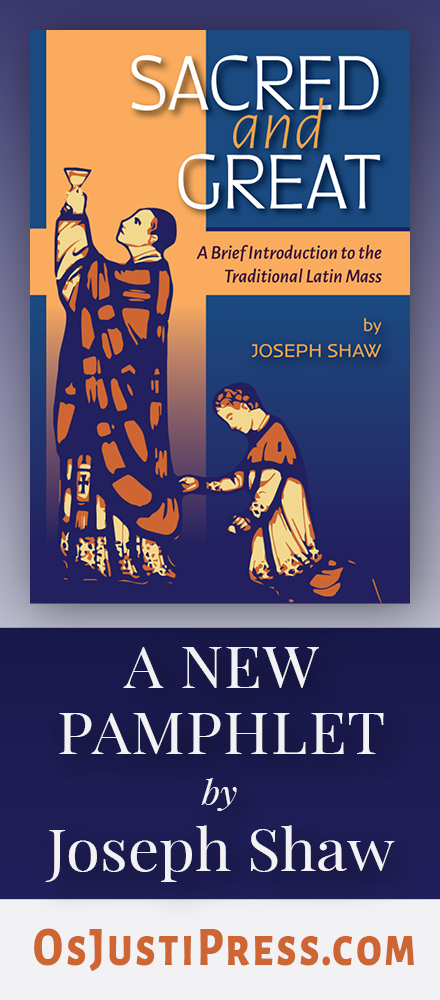It has become popular amongst a few today to assert that the use of the phrase “hermeneutic of continuity” is an invention. The assertion goes that the Pope did not speak of a "hermeneutic of continuity" and therefore to use it is to attribute something to the Pope which he did not say, and that, accordingly, this is inappropriate, if not also self-serving.
It is quite a bold and a serious claim to make when you think of it, but in point of fact, it is an erroneous assertion -- and potentially on two fronts.
The first is the question of the phrase itself. The fact is, the pope has indeed uttered that precise phrase. In Sacramentum Caritatis, the Pope explicates upon this hermeneutic in an explanatory footnote (#6) where he says:
I am referring here to the need for a hermeneutic of continuity also with regard to the correct interpretation of the liturgical development which followed the Second Vatican Council: cf. Benedict XVI, Address to the Roman Curia (22 December 2005): AAS 98 (2006), 44-45.
Those particularly reticent to let go of this assertion might attempt to suggest that “this is only a footnote,” but let it be pointed out that the root argument is simply the claim that the Pope never used that turn of phrase and therefore, we shouldn’t either. Clearly the above quotation demonstrates this assertion to be objectively untrue and therefore, such claims cannot be made with any accuracy. As for its importance by comparison with the 2005 Christmas address to the Roman Curia from whence these concepts originated, it cannot go without notice that the Pope uses this phrase, "the hermeneutic of continuity" as a contextual cross-reference to that same address, demonstrating clearly enough that phrase is indeed representative of his intended thought and categories.
This of course addresses the question of the Pope's use of the phrase itself, but it strikes me that we need to consider what may underlay this objection, which is, it seems to me, the more important part of this question; namely, what the meaning and application of these terms are.
While I will not suggest it is always the case, I often have found that this point is usually accompanied by the belief that there is a fundamental misinterpretation going on. In this regard, the attempt is usually made to emphasize the idea of “reform” rather than “continuity” -- as though they were somehow opposed. Now evidently, if one were to simply suggest that the Pope does not mean “continuity” in any immobilistic sense, this point would be fair enough; the Pope is not suggesting reform or development is outside the pale (more on that momentarily). But of course, this also does not speak against the concept of continuity -- quite the contrary -- and so there should be no cause for objection; nor should a dichotomy be established.
In point of fact, the Pope has used various descriptors to describe the two opposing hermeneutics in question; terms like “rupture” and “discontinuity” on the one hand, and a “reform”, “renewal in continuity”, and simply “continuity” on the other. The sense by which to understand these terms are both given in the famed 2005 address to the Roman Curia, and are also further explicated upon in various discourses and activities of the Pope.
It seems then that the Pope is defining "reform", or development, in its proper Catholic sense. That sort of reform (or renewal, development, etc.) is not the "reform" of political revolutionaries for instance, which is characterized by rupture, or a break or discontinuity with what came before, but rather reform/development/renewal which is characterized by continuity with the received tradition -- which also applies to the domain of liturgy of course.
This is a key, for instance, to understanding the Pope's recent statement that "anyone who wishes to be obedient to the [Second Vatican] Council has to accept the faith professed over the centuries, and cannot sever the roots from which the tree draws its life" (see here). It is likewise a key to understanding the liturgical writings and pursuits of the Pontiff, which are themselves a highlighted part of the Pope's programme of continuity, and which has begun to be known as the "liturgical reform of Pope Benedict XVI" -- a reform characterized by the project of re-establishing continuity with our liturgical tradition as it has been expressed and grown over the centuries. This also encompasses Summorum Pontificum, including those provisions which allowed for some development to that Missal.
In all of these things there is a common thread, and that thread is that which accepts the possibility of development, but it is a development which is always in visible continuity with our venerable tradition.




















